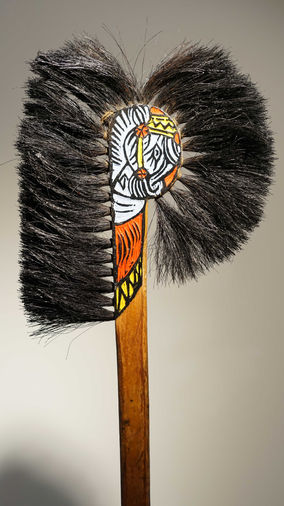MAL DONNE
Le Tarot Bruxellois : un hommage aux maîtres-cartiers oubliés
Le travail des cartiers bruxellois, fabricants de cartes à jouer et de tarots, est aujourd’hui largement méconnu. Pourtant, leur immense richesse graphique et symbolique transparaît dans la fragilité des quelques cartes qui nous sont parvenues. Cet artisanat, au XVIIIe siècle, comptait parmi les plus prestigieux d’Europe, au point que l’appellation « Tarot bruxellois » s’imposa dans le langage courant de l’époque (Alexandre Pinchart, p.35).
Avec l’arrivée de l’impression mécanisée et l’émergence d’autres jeux, tels que le tarot de Marseille, ce patrimoine a disparu presque entièrement, constituant une perte considérable. Mes recherches m’ont permis de découvrir quatre de ces jeux, ainsi que leurs créateurs : Jean Galler, Nicolas Bodet, Jean Demoulin et la famille Sarton. Ce projet artistique se veut un hommage à leur travail, mêlant recherche historique et création contemporaine.
Dans un premier temps, mes recherches ont porté sur une étude comparative des tarots bruxellois, permettant de restituer leur langage iconographique. J’ai isolé et reproduit divers fragments de cartes, que j’ai ensuite transposés sur des objets en bois trouvés dans les rues de Bruxelles. Ces objets abandonnés, réminiscences d’un passé oublié, dialoguent avec l’histoire du tarot bruxellois, une culture populaire souvent négligée dans l’histoire de l’art. Ces œuvres hybrides, oscillant entre sculpture et gravure, se dressent comme des totems et témoignages d’un héritage perdu.
La réédition d’un tarot oublié
Dans un second temps, j’ai entrepris de rééditer le tarot bruxellois, en m’inspirant des techniques du XVIIIe siècle. Ce « nouveau » tarot s’appuie sur les cartes originales issues de la collection d’estampes de la Bibliothèque Royale de Bruxelles, en particulier celles de Jean Galler et de la famille Sarton, dont des jeux quasi-complets subsistent encore.
Gravé sur bois, imprimé et coloré à la main selon les techniques traditionnelles de la gravure et de la dominoterie, ce tarot revisité joue également avec les codes contemporains. Il est proposé sous forme de DIVINATION BOOSTER : un petit paquet de cinq cartes aléatoires permettant à la fois une lecture cartomantique procédurale et une exploration partielle d’une collection de 22 cartes.
Cette recherche a été présentée pour la première fois lors de l’exposition MAL DONNE, au Carrefour des Arts, avec le soutien de la Fédération Wallonie-Bruxelles (2023).
The Brussels Tarot: A Tribute to Forgotten Card Makers
The work of Brussels card makers—creators of playing cards and tarot decks—is largely unknown today. Yet their immense graphic and symbolic richness is evident in the fragility of the few surviving cards. In the 18th century, this craft was among the most prestigious in Europe, to the point that the term "Brussels Tarot" became commonplace at the time.
With the advent of mechanized printing and the rise of other decks, such as the Marseille Tarot, this heritage almost entirely disappeared, representing a significant loss. My research uncovered four of these decks and their creators: Jean Galler, Nicolas Bodet, Jean Demoulin, and the Sarton family. This artistic project pays homage to their work, blending historical research and contemporary creation.
Initially, my research focused on a comparative study of Brussels tarots, enabling the restoration of their iconographic language. I isolated and reproduced various card fragments, transposing them onto wooden objects found on the streets of Brussels. These abandoned objects, remnants of a forgotten past, interact with the history of the Brussels tarot—a form of popular culture often overlooked in art history. These hybrid works, straddling sculpture and engraving, stand as totems and testaments to a lost heritage.
Recreating a Forgotten Tarot
In a second phase, I undertook the recreation of the Brussels tarot, inspired by 18th-century techniques. This "new" tarot draws on original cards from the print collection of the Royal Library of Brussels, particularly those by Jean Galler and the Sarton family, whose nearly complete decks still exist.
Engraved on wood, printed, and hand-colored using traditional engraving and block printing techniques, this reimagined tarot also incorporates contemporary elements. It is presented as a DIVINATION BOOSTER: a small pack of five random cards, offering both procedural cartomantic readings and a partial exploration of a 22-card collection.
This research was first presented during the exhibition MAL DONNE at Carrefour des Arts, with the support of the Wallonia-Brussels Federation (2023).



Les Divination Boosters sont disponibles au prix de 8 euros sur demande.
Ce paquet contient 5 cartes du tarot bruxellois sur les 22 à collectionner.
Ces images sont un hommage au travail des graveurs-cartiers belges du XVIIIe siècle, tout particulièrement
à Jean Galler et à la famille Sarton.
Ces cartes ont été gravées sur bois, colorisées et imprimées à la main.
signés et numérotés.
Divination Boosters
are available for €8 upon request.
Each pack contains 5 cards from the Brussels Tarot, out of a total of 22 collectible cards.
These images pay tribute to the work of 18th-century Belgian engraver-cardmakers, particularly Jean Galler and the Sarton family.
The cards have been hand-engraved on wood, hand-colored, and printed.
Each card is signed and numbered.























